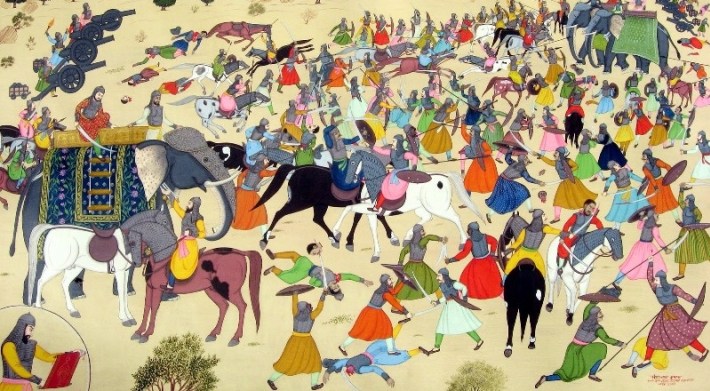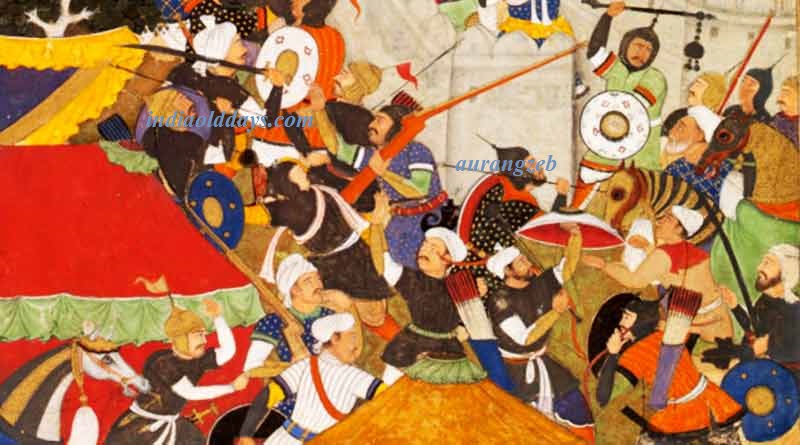Alauddin Khilji’s Vijay campaign

Other Important Facts-
- Technical and financial status of Delhi Sultanate
- Administrative System of the Mughals: Central Government
- Important literary sources of medieval Indian history
Alauddin Khilji was the first ruler of Delhi Sultanate who adopted the imperialist policy. Its campaigns have been described by many scholars in their texts.This is the following:
- Alauddin Khilji’s victory campaigns have been described in Ameer Khusro’s Granth Kjain-ul-Futuh.
- jiyauddeen Barani’s Fatwa- A -Jardari and thareekh-A -Firoz Shahi also reveal the conquests of Alauddin.
- The description of Isami and the Farishta- As soon as the ruling, Alauddin Khilji led a campaign of Multan under the leadership of his General Zia Ulugh Khan and destroyed the family of Jalaluddin Khilji.
Allauddin Khilji’s victorious campaigns were supported by several important generals. The Chief General is the following:
- Ulugh Khan (Almaru Beg)
- Nusrat Khan (Nusrat Jalseri)
- alp khaan
- Jafar Khan (Yusuf Khan) – It had the title of Sustam.
- Malik Kafoor (Tajuddin Kafur) – It was also called Thousand Dinari, because it was purchased in 1000 Dinar in Gujarat campaign. It was the abolition of Abyssinian (Ethiopia). It collaborated in the South campaign.
Allauddin’s campaigns are divided into two parts-
(I.) Campaign of North India
(II) Campaign of South India
Vijay campaign of North India –
Alauddin had won many states of northern India in this campaign. And the winning kingdoms were incorporated in their empire, and instead of conquering the kingdoms of the South by giving them their authority and accepting their submission instead of mixing them in their empire, they had the right to rule. The victorious states of North India are:
(1.) Gujarat campaign (1299 AD) – At this time the ruler of Gujarat was seen by Karn bghel. The reasons for the attack were:
(i) Economic importance of Gujarat- the importance of ports like Gujarat’s port city Surat, Bhadounch, Cambay, Khambhat The trade of Arabic and Iranian horses was done by these ports.
(ii.) Calling for help from Allauddin, to get power by Madhav, the minister of Raja Karan Baghel.
Alauddin Khilji sent a large army under the leadership of Ulugh Khan and Nusrat Khan, who attacked Jaisalmer and attacked Gujarat. Karna defeated Baghel and takes refuge with his daughter Devaladevi, Lord Ramchandra Deo, the ruler of Devgiri. While Karan Baghel’s wife Kamladevi is taken captive and sent to Delhi. Where Alauddin marries him and gives him the title of Malika-e-Jahan.
During this campaign, the Turkish army looted areas like Surat, Bhadounch and Cambay and damaged Somnath temple and bought Malik-Kafur.
Karna had gone to Gujarat with the help of Baghel, but the right to see Karna on keeping a small area was left.
(2.) Ranthambore expedition (1300-1301 AD) – The ruler here was Hammir Dev Chauhan.
There were several reasons for the attack on Ranthambore, which are as follows:
(i) Strategic importance of Ranthambore
(ii) During the Gujarat campaign, there was a difference between the New Mosul Soldier (Muhammad Khan) and the Turkish troops on the partition of the war of loot. Mongol Soldier King Hammir takes refuge in Dev Chauhan. The enemies of Alauddin Khilji were from Mongols.
Allauddin attacked Ranthambore under the leadership of Nusrat Khan, in which Nusrat Khan was killed. Alauddin Khilji then campaigned himself.
Due to the betrayal of the Rajput warlords named Rampal and Rattalp, the Turkish army entered the fort and Hammeer got killed and his wife, Sangeethi jawed.
It was the first Johar.
In this campaign Amir Khusro was also with Alauddin, he has given a live description of this jeweler. In this campaign Amir Khusro was also with Alauddin, he has given a live description of this Johar .
(3.) Chittor campaign (1303 AD) – Rana Ratnasinh was the ruler of Chittor.
The following are due to the attack of Chittor:
(i) The strategic importance of Chittor- The fort of Chittong was the strong fort on the south side.
(ii.) Lust of achieving Padmini.
Alauddin, after a few months of siege, won the Chittorgarh fort here, but here also Jawar under the leadership of Padmini. (First Saka of Chittong)
Allauddin named Chittor after the name of his son Khizrakha and made it a fortress. After this, Alauddin made a Rajput officer Maldev as the fortress of Chittaur. But in 1321 AD, Rana Hmmir again won the Chittaur.
(4) Campaign of Malwa (1305 AD) – The ruler here was Mahadeleva who was in charge of the administration with the help of the Coca Pradhan.
Due to the Malwa campaign-
- Empire expansion
Alauddin Khilji led the army under the leadership of N-Ul-Multani and conquered Malwa.
(5) Shivena (Barmer, Raj.) (1308 AD) – Here the ruler was Shitaldev / Satdev, (Sonargara Chauhan). Allauddin Khilji had defeated this.
(6.) Jalore (Raj.) (1311 AD) – Here the ruler Kanhradev was the songara Chauhan. According to some texts, in the time of the Jalore campaign, Allauddin had a symbolic attack under the leadership of his servant Gul-e-Bahist.
NOTE- The description of Alauddin’s Jalore campaign is given in the Kanhangdeva management composed by Padmanabh.
- By winning the areas of Sevana and Jalore areas, Alauddin made his official Kamaluddin Garg an officer in both sectors.
- Alauddin directly conquered the territories of northern India and got his kingdom together.
The victory campaign of South India-
The purpose of south operations of Alauddin Khilji was to get the money, so by conquering the southern regions, Allauddin embraced the practical policy, instead of directly converting it into his empire, dominated the southern states. (Keeping yourself subjected to) the principle.
The conquered states in the South campaign are:
(1.) Devgiri (Maharashtra) (1306) – The ruler here was Ramachandra Dev (Yadav dynasty).
Following are the reasons for attack on Devgiri.
(i) To help and protect Karn bghel.
(ii) Ramachandra stopped paying tax after the operation of 1296 AD.
(iii.) Kamla Devi wanted to get her daughter Deval Devi.
Alauddin Khilji sent a Devgiri campaign under the leadership of Malik Kafoor and the AlpKha.
The Alp Khan defeated Karn Baghel and sent Deval Devi to Delhi, where he got married to Alauddin’s son Khizrakha. On this, a texts were written Devarani Khijrakhan (Aashikana).
Malik Kafur gave Ramchandra equal, gave the title of Raiy Raya for establishing friendship and gave one lakh taka gifts and fortress of Navsari (Gujarat) Ramchandra Dev. In exchange, Ramchandra Dev was restored to the power of Devgiri under his control and regular tax and The Treaty of Military Assistance for South Expeditions.
Note: “Alauddin was the forerunner of Akbar in relation to making friendly relations with the defeated rulers.”
After Ramchandra’s death in 1313 AD, the ruler of Devgiri, Shankardev (Singhsen) became the new ruler. It severed relations with the Delhi Sultanate. Malik Kafur again attacked Devgiri, Shankardev was killed. The large part of Devgiri was merged with the Delhi Sultanate.
In the year 1315 AD, Alauddin’s treaty with Shankardev’s successor Harpaldev was made. Devapati’s ruler Harpaldev was accepted.
(2.) Kakatiya (Warangal) dynasty (1310-11 AD) – Here the ruler was Prataparudra II. A campaign was organized in 1310-11 AD under the leadership of Malik Kafur. Prataparudra Dev accepted the defeat. Ramachandra had provided military assistance in this campaign.
Prataparudra Dev, instead of going to Delhi, sent his Delhi gold idol submission to Delhi, accepting annual tax payment. In this campaign, Kafur has given Kohinoor diamond Loota-details of which Khafi Khan has done.
(3.) The ruler of the Hoysal dynasty of Dwarasamudra (1311 AD) – here was the ruler Baldev III. Kafoor defeated Baldev and sent him to Delhi. Alauddin established friendship with Balladeva, provided 10 lakh rupees gift and a chhatra etc. Ramadindra’s general, Parasdev had assisted Kafur. Balladeva told Kafur the road to reach Madura (Tamil Nadu).
(4) The Pandya ruler of Madura (1311 AD) – After the death of Marwarman Kul Shekhar, war was going on to gain power between both the Veer Pandya and the Sundar Pandya brothers. At the same time Kafur invaded and the two brothers fled the capital and fled.
According to Amir Khusro, Kafoor campaigned for Rameswaram (remote Tamil Nadu) and destroyed the temple and made the temple. Malik Kafur received the highest amount of money in this campaign.
Veer Pandya and Sundar Pandey neither became criminally nor accepted the submission.
Reference : https://www.indiaolddays.com/





